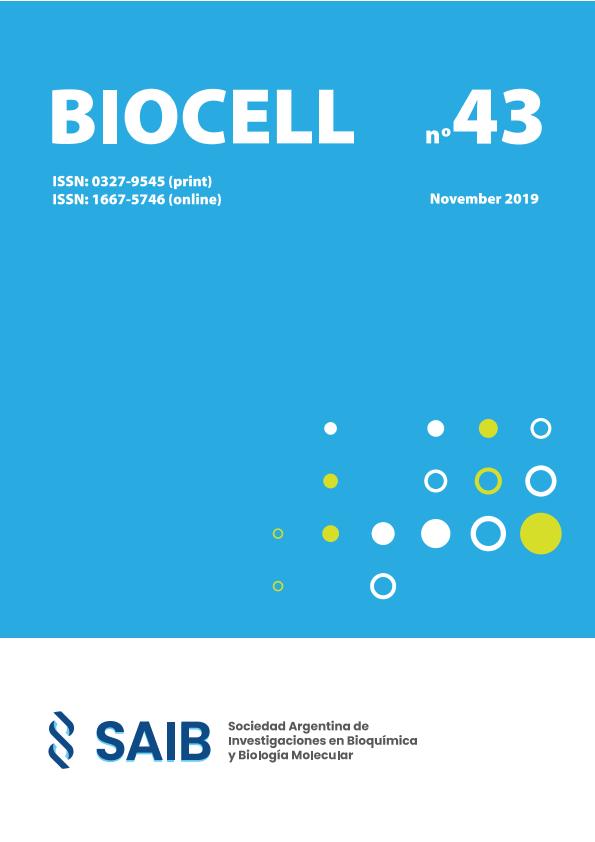Mostrar el registro sencillo del ítem
dc.contributor.author
Veuthey, Tania Vanesa

dc.contributor.author
Giunti, Sebastián

dc.contributor.author
de Rosa, Maria Jose

dc.contributor.author
Rayes, Diego Hernán

dc.date.available
2023-03-08T17:17:27Z
dc.date.issued
2019
dc.identifier.citation
The flight response induces the release of an ILP from the intestine to inhibit cytoprotective mechanisms in C. Elegans; Congreso de la Sociedad Argentina de Investigaciones en Bioquímica y Biología Molecular; Salta; Argentina; 2019; 50-51
dc.identifier.uri
http://hdl.handle.net/11336/189954
dc.description.abstract
The perpetuation of the flight response inhibits defensive cytoprotective mechanisms, leading to reduced resistance to environmental stressors, early onset of age-related disorders and shorter lifespan from invertebrates to mammals. We have recently shown that, in Caenorhabditis elegans, the flight response induces the neuronal release of Tyramine (TA, the invertebrate analog of adrenaline), which stimulates the adrenergic-like receptor TYRA-3 in the intestine. This leads to the activation of the DAF-2/Insulin/IGF-1 pathway and the inhibition of cytoprotective mechanisms, such as translocation of DAF-16/FOXO or HSF-1, not only in the intestine but also in other tissues. However, the signals that bridge the stimulation of TYRA-3 in the intestine with the activation of the DAF-2 insulin receptor in other tissues remain unknown. C. elegans genome encodes 40 Insulin-like peptides (ILPs), which in principle could bind to DAF-2, and many of them are expressed in the intestine. We, therefore, used RNAi to individually silence intestinal ILPs and test the resistance to environmental stressors such as oxidative and thermal stress. We found that the silencing of one of those ILPS, ins-3, improves the resistance to environmental stressors. In contrast to control, the addition of exogenous TA does not impair the oxidative or thermal stress resistance in ins-3-silenced animals. Moreover, we generated double null mutants of ins-3 and TAdeficient mutants and found that this double mutant is as resistant to environmental stress as single mutants. This suggests that tyramine and INS3 act in the same pathway to control stress resistance. Since ins-3 is also expressed in neurons, we injected ins-3 cDNA driven by intestinal and neuronal promoters to ins-3 null mutant animals, to assess the tissue where the expression of ins-3 is relevant for controlling stress resistance. We found that only intestinal expression of ins-3 restores the resistance to wild-type levels. Moreover, we found that the stress resistance of ins-3 null mutants is mediated, at least partially, by DAF-16/FOXO. We, therefore, propose that the activation of the intestinal GPCR TYRA-3 by the escape neurohormone TA leads to the release of INS-3 which acts as endocrine, autocrine and/or paracrine signal to activate the insulin receptor DAF-2 not only in the intestine but also in distal tissues. Given the high degree of conservation of fundamental mechanisms among species, this study can contribute to understanding molecular pathways and cellular communication involved in neural regulation of stress response in multicellular organisms.
dc.format
application/pdf
dc.language.iso
eng
dc.publisher
Sociedad Argentina de Investigaciones en Bioquímica y Biología Molecular (SAIB).
dc.rights
info:eu-repo/semantics/openAccess
dc.rights.uri
https://creativecommons.org/licenses/by-nc-sa/2.5/ar/
dc.subject
INSULIN
dc.subject
STRESS
dc.subject
C.ELEGANS
dc.subject
LIFESPAN
dc.subject.classification
Bioquímica y Biología Molecular

dc.subject.classification
Ciencias Biológicas

dc.subject.classification
CIENCIAS NATURALES Y EXACTAS

dc.title
The flight response induces the release of an ILP from the intestine to inhibit cytoprotective mechanisms in C. Elegans
dc.type
info:eu-repo/semantics/publishedVersion
dc.type
info:eu-repo/semantics/conferenceObject
dc.type
info:ar-repo/semantics/documento de conferencia
dc.date.updated
2023-02-16T10:12:09Z
dc.identifier.eissn
1667-5746
dc.journal.volume
43
dc.journal.number
Suplemento V
dc.journal.pagination
50-51
dc.journal.pais
Argentina

dc.journal.ciudad
Buenos Aires
dc.description.fil
Fil: Veuthey, Tania Vanesa. Consejo Nacional de Investigaciones Científicas y Técnicas. Centro Científico Tecnológico Conicet - Bahía Blanca. Instituto de Investigaciones Bioquímicas de Bahía Blanca. Universidad Nacional del Sur. Instituto de Investigaciones Bioquímicas de Bahía Blanca; Argentina. Universidad Nacional del Sur. Departamento de Biología, Bioquímica y Farmacia; Argentina
dc.description.fil
Fil: Giunti, Sebastián. Consejo Nacional de Investigaciones Científicas y Técnicas. Centro Científico Tecnológico Conicet - Bahía Blanca. Instituto de Investigaciones Bioquímicas de Bahía Blanca. Universidad Nacional del Sur. Instituto de Investigaciones Bioquímicas de Bahía Blanca; Argentina. Universidad Nacional del Sur. Departamento de Biología, Bioquímica y Farmacia; Argentina
dc.description.fil
Fil: de Rosa, Maria Jose. Consejo Nacional de Investigaciones Científicas y Técnicas. Centro Científico Tecnológico Conicet - Bahía Blanca. Instituto de Investigaciones Bioquímicas de Bahía Blanca. Universidad Nacional del Sur. Instituto de Investigaciones Bioquímicas de Bahía Blanca; Argentina. Universidad Nacional del Sur. Departamento de Biología, Bioquímica y Farmacia; Argentina
dc.description.fil
Fil: Rayes, Diego Hernán. Consejo Nacional de Investigaciones Científicas y Técnicas. Centro Científico Tecnológico Conicet - Bahía Blanca. Instituto de Investigaciones Bioquímicas de Bahía Blanca. Universidad Nacional del Sur. Instituto de Investigaciones Bioquímicas de Bahía Blanca; Argentina. Universidad Nacional del Sur. Departamento de Biología, Bioquímica y Farmacia; Argentina
dc.relation.alternativeid
info:eu-repo/semantics/altIdentifier/url/https://newsite.saib.org.ar/publicaciones/
dc.relation.alternativeid
info:eu-repo/semantics/altIdentifier/url/https://saib.org.ar/archivos/biocell-43.pdf
dc.conicet.rol
Autor

dc.conicet.rol
Autor

dc.conicet.rol
Autor

dc.conicet.rol
Autor

dc.coverage
Internacional
dc.type.subtype
Congreso
dc.description.nombreEvento
Congreso de la Sociedad Argentina de Investigaciones en Bioquímica y Biología Molecular
dc.date.evento
2019-11-05
dc.description.ciudadEvento
Salta
dc.description.paisEvento
Argentina

dc.type.publicacion
Journal
dc.description.institucionOrganizadora
Sociedad Argentina de Investigaciones en Bioquímica y Biología Molecular
dc.description.institucionOrganizadora
Panamerican Association for Biochemistry and Molecular Biology
dc.source.revista
Biocell

dc.date.eventoHasta
2019-11-08
dc.type
Congreso
Archivos asociados
